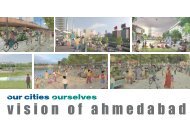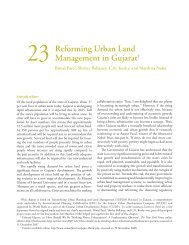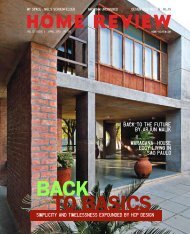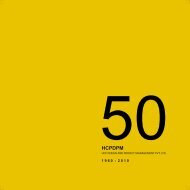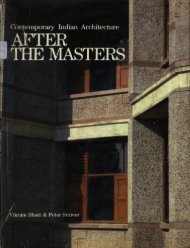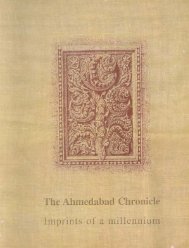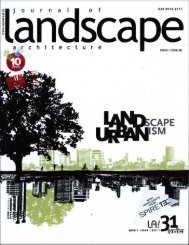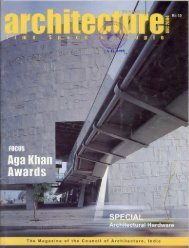Domus India, November - HCP Design and Project Management Pvt ...
Domus India, November - HCP Design and Project Management Pvt ...
Domus India, November - HCP Design and Project Management Pvt ...
Create successful ePaper yourself
Turn your PDF publications into a flip-book with our unique Google optimized e-Paper software.
46<br />
Dinesh Mehta<br />
08.01.2011<br />
Ahmedabad, IN<br />
Nikon D3<br />
45mm<br />
5,6<br />
1/1000 s<br />
domus 01 <strong>November</strong> 2011<br />
Louver as<br />
protagonist<br />
Addressing the negotiation of the interior with the climate of the city, Bimal Patel <strong>and</strong><br />
his multi-disciplinary team design the hardware for the skins of three buildings<br />
<strong>Design</strong><br />
Bimal Patel<br />
Texts<br />
Smita Dalvi<br />
Bimal Patel<br />
Photos<br />
Dinesh Mehta<br />
Sachin Desai<br />
Niki Shah<br />
Ahmedabad has three new buildings; not public nor<br />
institutional, nor extravagant in form. They are modest,<br />
private <strong>and</strong> commercial. They are all designed by <strong>HCP</strong>, an<br />
architectural firm well-known for large institutional projects.<br />
Addressing the negotiation of the interior with the climate of<br />
the city, Bimal Patel <strong>and</strong> his multi-disciplinary team from <strong>HCP</strong><br />
have designed the hardware for the skins of three buildings.<br />
These are special, for each building displays an almost retromodern<br />
aesthetic on their facade, articulated by an element<br />
now rarely seen—the ‘louver’.<br />
Louvers as shading devices are an innovation of modernist<br />
architecture in <strong>India</strong>; a new vocabulary unbeholden to history<br />
or tradition, but a contemporary interpretation of a regional<br />
response. ‘Thermal control’, or simply put, keeping the heat out,<br />
is a primary necessity in most arid <strong>India</strong>n regions. In humid<br />
zones, ventilation becomes an added criterion. Traditional or<br />
vernacular buildings exhibit a variety of responses to this<br />
situation by incorporating buffers of thick walls <strong>and</strong> heavy<br />
roofs with fewer openings, deep balconies or ver<strong>and</strong>ahs,<br />
courtyards, shaded outdoor spaces, deep overhanging roofs,<br />
<strong>and</strong> so on. These responses were once shaped by traditional<br />
wisdom <strong>and</strong> an intimate, intuitive underst<strong>and</strong>ing of one’s<br />
immediate environment. Modernism, on the other h<strong>and</strong>,<br />
sought a rational approach that expressed the spirit of the age.<br />
The louver, taking various avatars, played an active role in<br />
creating an illuminated trajectory all its own.<br />
In <strong>India</strong>, the period between the two world wars was a<br />
fluid one in which ideas <strong>and</strong> people travelled freely across<br />
continents. A l<strong>and</strong>mark building of these times is the<br />
‘Golconde’—a dormitory for the Aurobindo Ashram in<br />
Pondicherry (1938), designed by Antonin Raymond of Czech<br />
origin who came to <strong>India</strong> via Japan, where he worked with<br />
Frank Lloyd Wright on the Imperial Hotel. This RCC frame<br />
structure remains a paragon for subcontinental climatic<br />
architecture. The long faces on the North <strong>and</strong> South are<br />
articulated with custom-designed lightweight movable<br />
horizontal louvers made of asbestos cement. The entire façade<br />
acts not just as a shading device but also as a breathing<br />
mechanism for the building in the oppressively warm <strong>and</strong><br />
humid climate of Pondicherry.<br />
Since independence, the city of Ahmedabad has been at the<br />
forefront of Modernism in <strong>India</strong>. This trend was promoted by<br />
Ahmedabad<br />
a h<strong>and</strong>ful of mercantile families who commissioned private<br />
<strong>and</strong> public work to international architects like Le Corbusier<br />
<strong>and</strong> Louis Kahn, both figureheads of the 20th century Modern<br />
movement in architecture. Le Corbusier’s iconic project on the<br />
banks of the Sabarmati River is the Ahemdabad Millowners’<br />
Association headquarters building (1954-56). This building<br />
gives material form to many of his theories like the free plan<br />
<strong>and</strong> open façade, the roof garden <strong>and</strong> a form-finished concrete<br />
frame. But unlike any of his previous buildings in Europe, Le<br />
Corbusier negotiated the hot climate of Ahmedabad through<br />
the innovative ‘brise soleil’. On both the east <strong>and</strong> west faces<br />
of the building he created a substantive buffer between floor<br />
plates <strong>and</strong> the exterior, using horizontal ledges <strong>and</strong> extra<br />
wide vertical louvers of concrete. Although the brise soleil<br />
element was simultaneously employed at Ch<strong>and</strong>igarh where<br />
he was shaping great buildings in the new capital for the<br />
state of Punjab (1951-60) on the invitation of Prime Minister<br />
Jawaharlal Nehru, it is the modest Millowners’ building in all<br />
its simplicity that remains etched in the memory for its bold<br />
aesthetics of the louver. Architects in Ahmedabad, some of<br />
whom apprenticed under the master continued the legacy of<br />
modernism tempered by the local <strong>and</strong> contextualised by the<br />
vernacular. Charles Correa’s G<strong>and</strong>hi Smarak Sangrahalaya at<br />
the Sabarmati Ashram, a project of modest size <strong>and</strong> proportion,<br />
is perhaps the best work of his career. Here, the modular spaces<br />
formed by a grid of piers have no walls; <strong>and</strong> enclosure, where<br />
desired, is provided by fixed horizontal louvers.<br />
Contemporary to the Ch<strong>and</strong>igarh project was a commercial<br />
building in Bombay, the Petroleum House, Churchgate (1954),<br />
by Chauncey W. Riley that st<strong>and</strong>s out for its unique aesthetic.<br />
The cuboidal mass rounded at the street junction is completely<br />
wrapped with vertical louvers in pre-cast concrete which are<br />
differently positioned for specific orientation. In addition to<br />
the vertical, there are some horizontal fins made in asbestos<br />
cement to further augment the efficiency of shading in the<br />
south direction. This was expressly done to reduce the cooling<br />
load on the AC system. A few blocks away, the ‘Yogakshema’,<br />
LIC headquarters designed by D. K. Choudhary also employed<br />
the language of concrete louvers as vertical fins. In the latesixties<br />
<strong>and</strong> the early seventies the ‘egg-crate’ articulation of<br />
the façade was de rigueur in many public buildings all over the<br />
country.<br />
47
Louver as protagonist Ahmedabad, IN<br />
<strong>HCP</strong> have employed<br />
technology as a powerful<br />
<br />
the architectural language of<br />
Safal Corporate House<br />
48<br />
domus 01 <strong>November</strong> 2011<br />
In accepting its role<br />
as a mechanism of creating<br />
private value, architecture<br />
is at liberty to pursue its everpresent<br />
dream of formally<br />
autonomous projects<br />
—<br />
By the eighties though, the use of louvers withered practically<br />
to nonexistence. Why did the louver fall out of favour? One<br />
possible reason was the difficulty in casting thin, light<br />
louvers with precise line <strong>and</strong> plane in concrete <strong>and</strong> the lack<br />
of transparency <strong>and</strong> flexibility. The cement crisis in the early<br />
eighties may also have led to the louver being regarded as<br />
vestigial to the building itself. Later, in newer, developergenerated<br />
buildings, even deep overhangs <strong>and</strong> balconies were<br />
considered a waste of space—anything more specialised or<br />
complex was almost eliminated. The typical façades of today<br />
are thin skins of masonry or glass without adequate shading<br />
or insulation, near-naked buildings that are visual <strong>and</strong><br />
environmental disasters.<br />
In contemporary times, the ways of life, functions <strong>and</strong><br />
types of buildings <strong>and</strong> the dem<strong>and</strong>s we put on them have<br />
undergone a drastic <strong>and</strong> irretractable change. Moreover, in<br />
a rapidly urbanising country these very dem<strong>and</strong>s also put<br />
an unprecedented strain on the physical environment <strong>and</strong><br />
energy resources. While we can learn a few lessons from the<br />
traditional methods, it would be naïve to replicate them as<br />
they were. The challenge for the <strong>India</strong>n architect today is to<br />
offer contemporary aesthetic <strong>and</strong> technological possibilities<br />
that are neither alien nor retrospective. One very potent design<br />
method is climatic design, maintaining the thermal balance of<br />
interior spaces by using passive design, minimising heat gain<br />
<strong>and</strong> maximising heat loss, promoting natural <strong>and</strong> induced<br />
ventilation, maximising daylight <strong>and</strong> reducing cooling loads<br />
on mechanical systems. An underst<strong>and</strong>ing <strong>and</strong> working<br />
knowledge of building physics, climate, <strong>and</strong> solar geometry is<br />
imperative to achieve effective solutions. Effective shading,<br />
ventilation, insulation <strong>and</strong> transparency are simple, useful<br />
goals. The three buildings in Ahmedabad capture this essence.<br />
They are special for displaying a unique sensibility in their<br />
exterior which is worthy of attention.<br />
Schematic diagrams<br />
depicting the temperature<br />
<br />
are employed <strong>and</strong> when the<br />
building skin is reduced to a<br />
thin surface<br />
49
Louver as protagonist Ahmedabad, IN<br />
50<br />
The space between the<br />
vertical rigid louver system<br />
<strong>and</strong> the inner skin controls<br />
the heat accepted by the<br />
<br />
into the plywood system<br />
<br />
suit the visual <strong>and</strong> climatic<br />
dimensions of the building<br />
domus 01 <strong>November</strong> 2011<br />
The Safal Corporate House is a three-storied, fair face concrete<br />
structure located on a west-oriented plot. It has expansive<br />
windows on the main façade that are protected from the harsh<br />
afternoon sun by vertically pivoted wooden louvers which also<br />
add architectural interest to a monolithic <strong>and</strong> grey concrete<br />
exterior. Safal Corporate House has to deal with a challenging<br />
orientation since the long facade faces west, which is the most<br />
difficult face to shade as the sun makes a low angle in the sky<br />
directly in front, coinciding with the overheated period of the<br />
day. The vertical louvers would be the only effective solution to<br />
prevent direct glare <strong>and</strong> considerable heat gain, but permitting<br />
reflected daylight inside. That they are movable would help in<br />
making the necessary adjustment from summer to winter.<br />
Retractable louvers are much more efficient than fixed brise<br />
soleil. For one, they afford better <strong>and</strong> more intuitive solar<br />
control as well as catch prevailing breezes more effectively.<br />
Secondly, they can be constructed with lightweight materials<br />
with better thermal properties rather than in concrete which is<br />
heavy <strong>and</strong> has a higher ‘U-value’- rendering it thermally poor.<br />
Safal Profitaire is a multi-tenanted office complex with more<br />
than 50% of its façade glazed for lighting efficiency. This is<br />
protected by a Vertical Rigid Louver System (VRLS) made from<br />
cement bonded fiber board panels with insulation. The system<br />
is mounted on a 60cm wide ledge on every floor the louvers<br />
extend from slab to slab are linked together to form arrays<br />
<strong>and</strong> can be operated manually with one control. Each louver<br />
is made up of two segregated panels that overlap, as such, in<br />
the fully closed position light filters through to create a glow<br />
of natural light in the interior. The challenging part is any<br />
moving component in a building would require much greater<br />
efficiency in detailing, h<strong>and</strong>ling <strong>and</strong> maintenance. They will<br />
need to be simple <strong>and</strong> sturdy to be easily operable without<br />
breaking down. The VRLS designed for Safal Profitaire achieves<br />
effective screening of the sliding aluminum glazed windows.<br />
The gap between the two skins also helps to maintain air-flow<br />
<strong>and</strong> in cooling the façade.<br />
The Astral Corporate House’s main glazed façade faces north<br />
<strong>and</strong> is mediated with a partial roller membrane system<br />
mounted on a 60cm wide ledge on the exterior. Although the<br />
north façade would receive less solar radiation, it requires<br />
shading nonetheless, especially during the summer. Louvers<br />
that are made of fabric create diffused lighting in the interior<br />
creating an environment which is glare-free <strong>and</strong> comfortable.<br />
Louver systems thus employed protect building interiors from<br />
Manually adjustable louvers<br />
allow for a great degree of<br />
<br />
interior environment, both<br />
in terms of light <strong>and</strong> air<br />
circulation<br />
The facade of Safal<br />
<br />
vertical rigid louver system<br />
(VRLS) made from cement<br />
<br />
with insulation<br />
51
Louver as protagonist Ahmedabad, IN<br />
52<br />
—<br />
The operable rather than fixed<br />
louvers make the building facade<br />
dynamic <strong>and</strong> help in mitigating<br />
the effects of Ahmedabad's<br />
harsh climate<br />
—<br />
domus 01 <strong>November</strong> 2011<br />
solar heat gain, keep cool the exterior faces of buildings limit<br />
glare, allow reflected daylight to filter through which can be<br />
varied by users depending upon the changing solar angles as<br />
per the time of the day <strong>and</strong> the season, <strong>and</strong> provide mediated<br />
views of the outdoors from the inside.<br />
Most commercial, corporate <strong>and</strong> even institutional buildings<br />
in <strong>India</strong>’s emerging urban centres today display a disturbing<br />
disregard for negotiating their local climate. Typical façades<br />
now are thin skins of masonry or glass without adequate or<br />
almost no shading or insulation, near-naked buildings that<br />
are eyesores <strong>and</strong> environmental disasters. More attention <strong>and</strong><br />
money is being paid to make these unviable skins shiny <strong>and</strong><br />
glossy rather than how they will protect inhabitants from heat<br />
<strong>and</strong> damp. What is seen is the creation of artificial, fantastical,<br />
insular interior environments powered by mechanical systems<br />
that completely shut out the outside of a chaotic city by<br />
wrapping themselves with fancy cloaks. These cloaks start<br />
withering very fast under a punishing sun <strong>and</strong> driving rain.<br />
The resultant ugliness has fouled the urbanism of our cities<br />
<strong>and</strong> robbed them of any aesthetic or human quality.<br />
<strong>HCP</strong>’s oeuvre of many years has carried forward the vigour<br />
of Ahmedabad’s modernism. Here they have drawn upon<br />
the movement’s most relevant building element for the<br />
subcontinent, the louver, <strong>and</strong> have revived it to fulfill the<br />
challenges of contemporary times. The firm <strong>and</strong> its associate<br />
product design team have invested in R&D to reduce the<br />
bulkiness of louvers as they were conceived by the high-<br />
modernists <strong>and</strong> have re-imagineered them in different<br />
materials chosen for their thermal properties, shaping new,<br />
streamlined <strong>and</strong> elegant forms, operable rather than fixed<br />
making the building façade dynamic <strong>and</strong> help in mitigating<br />
the effects of Ahmedabad’s harsh climate. The range of<br />
materials is as deep as wide, from rigid asbestos cement<br />
to earthy wooden to almost ephemeral fabric, each made<br />
workable with painstaking details of hardware. In today’s<br />
world, where building edges cannot be deep <strong>and</strong> elaborate<br />
due to the need to extract every inch of floor space, these<br />
solutions offer a new approach to the development of effective<br />
façades providing comfortable conditions to its inhabitants<br />
<strong>and</strong> a sense of wellbeing <strong>and</strong> delight through passive design<br />
solutions rather than through active measures like airconditioning.<br />
The operable louver so becomes a dynamic<br />
protagonist determining the overall aesthetic of the buildings<br />
<strong>and</strong> also a pointer towards saner <strong>and</strong> more humane cityscapes.<br />
—<br />
SMITA DALVI<br />
Architect <strong>and</strong> critic<br />
Astral Corporate House has<br />
a unique louver system made<br />
of fabric, developed by the<br />
industrial design team at <strong>HCP</strong><br />
<br />
<br />
<br />
strong daylight<br />
53
Louver as protagonist Ahmedabad, IN<br />
1 Entrance plaza<br />
2 <br />
3 Meeting area<br />
4 Toilets<br />
5 Security cabin<br />
54<br />
4<br />
2<br />
1<br />
Site area<br />
Total built area<br />
3<br />
1012 m 2<br />
1720 m 2<br />
5<br />
<br />
A Top Strip<br />
B Top Strip Cover<br />
C Link Rod<br />
D Link And Link Bush<br />
E Allen Cap<br />
F Link Connector And Pivot<br />
G Column Pipe<br />
H Panel Bracket (L Type)<br />
I Allen Csk<br />
J Panel Bracket Holder (S Type)<br />
K Bracket Holder Spacer Pin<br />
M Stopper H<strong>and</strong>le<br />
N H<strong>and</strong>le<br />
O Stopper Pin<br />
P Column Holder<br />
Q Column Holder Cover<br />
R Lock Plate<br />
S H<strong>and</strong>le Stopper And O Ring<br />
F<br />
A<br />
B<br />
C<br />
D<br />
E<br />
G<br />
H<br />
I<br />
J<br />
K<br />
L<br />
M<br />
N<br />
O<br />
P<br />
Q<br />
R<br />
S<br />
domus 01 <strong>November</strong> 2011<br />
0 5m <br />
<br />
0 5m<br />
A<br />
A<br />
<br />
I<br />
C<br />
<br />
<br />
<br />
B C<br />
<br />
B<br />
<br />
<br />
<br />
<br />
6<br />
I<br />
3<br />
3<br />
3 3 3<br />
3 2<br />
3 3<br />
1<br />
2<br />
3<br />
4<br />
Entrance<br />
Lobby<br />
<br />
Water Body<br />
5<br />
5<br />
6<br />
7<br />
6<br />
5<br />
Parking<br />
Sub Station<br />
Plaza<br />
I<br />
7<br />
4<br />
5<br />
0 20m<br />
5<br />
Site area<br />
Total built area<br />
11534 m 2<br />
28000 m 2<br />
55
Louver as protagonist Ahmedabad, IN<br />
In a tropical country like <strong>India</strong> where the weather is mostly<br />
hot, <strong>and</strong> the glare of the sun can be often unbearable,<br />
architects have always taken the task of shading facades<br />
very seriously. Within modern <strong>India</strong>n architecture, one can<br />
find different shading strategies <strong>and</strong> devices. Think of the<br />
thin, flat <strong>and</strong> wide weather shades which are a key feature<br />
of art-deco architecture; or, Corbusier’s ‘brise-soleil’ on the<br />
West facade of the Millowners' Association Building; or the<br />
incredible concrete louvers of Antonin Raymond’s Golconde;<br />
or, the austere balconies in Kahn’s IIM hostel blocks providing<br />
a protective layer for the rooms—the list is endless. In fact,<br />
shading strategies are at the heart of <strong>India</strong>n architecture <strong>and</strong><br />
<strong>India</strong>n architects have prodigiously developed a variety of<br />
approaches to shading.<br />
Today, there seems to be a renewed vigour in developing new<br />
ways of shading. A number of architects all over the country<br />
56<br />
are trying out new strategies <strong>and</strong> this new exploration, I think,<br />
is spurred primarily by the prohibitive cost of using a thick<br />
b<strong>and</strong> of space all along the perimeter of buildings for shading.<br />
Floor space is just too precious <strong>and</strong> it is simply impossible to<br />
‘waste’ all the space that Corbusian ‘brise-soleil’, or Kahnian<br />
layer of balconies use up. Raymond’s concrete louvers seem<br />
attractive however, developers would much rather have light<br />
facades that do not add weight to the structure.<br />
A group of us at <strong>HCP</strong>DPM, along with Dinesh Sharma (an<br />
industrial designer) <strong>and</strong> the production team at TDW Furniture<br />
<strong>Pvt</strong>. Ltd. led by Ismet Khambatta, have been experimenting<br />
with a variety of shading systems for building facades made of<br />
cement bonded fiber board, marine plywood <strong>and</strong> fabric.<br />
—<br />
BIMAL PATEL<br />
Architect<br />
domus 01 <strong>November</strong> 2011<br />
The lightweight <strong>and</strong> movable<br />
louver system helps in<br />
negotiating the relationship<br />
between the interior <strong>and</strong> the<br />
outside, protecting the inside<br />
<br />
<strong>and</strong> the harsh glare of the<br />
tropical sun<br />
57
Louver as protagonist Ahmedabad, IN<br />
The south facade<br />
of the Safal<br />
Corporate House<br />
58<br />
domus 01 <strong>November</strong> 2011<br />
Interior view of the<br />
stairwell in the Safal<br />
<br />
Architect<br />
<strong>HCP</strong> DESIGN AND PROJECT<br />
MANAGEMENT PVT. LTD<br />
BIMAL PATEL<br />
<strong>Project</strong> team<br />
BIMAL PATEL<br />
ANAND PATEL<br />
MAHESH IYER<br />
RAKESH RAJPUT<br />
MAHENDRA PATEL<br />
AMIT SHAH<br />
GUNWANT VADGAMA<br />
SHYAMU SHAH<br />
Facade system<br />
FACE FAÇADE APPLICATIONS<br />
FOR CONSERVATION OF ENERGY<br />
(A DIVISION OF TDW FURNITURE<br />
PVT. LTD.)<br />
<strong>Design</strong><br />
DINESH SHARMA<br />
DEVELOPMENT,<br />
MANUFACTURING AND<br />
INSTALLATION: ISMET<br />
KHAMBATTA, ANNU<br />
ANAND,RAJIV SHAH,KETAN<br />
PANCHAL, NEERAJ PARMAR,<br />
MAULIK SAVALIA<br />
Interior design<br />
<strong>HCP</strong> INTERIOR ARCHITECTURE<br />
PVT. LTD<br />
<strong>Design</strong> team<br />
CANNA PATEL (Principal<br />
<strong>Design</strong>er)<br />
MILI AMIN<br />
SONAL PATEL<br />
L<strong>and</strong>scape design<br />
DESIGN CELL (aal protaire)<br />
Structural engineer<br />
DUCON CONSULTANTS PVT. LTD.<br />
(SAFAL PROFITAIRE AND SAFAL<br />
CORPORATE OFFICE)<br />
N.K. SHAH & ASSOCIATES<br />
(ASTRAL CORPORATE HOUSE)<br />
Client<br />
SAFAL PROFITAIRE<br />
SAFAL CORPORATE OFFICE<br />
ASTRAL CORPORATE HOUSE<br />
59




